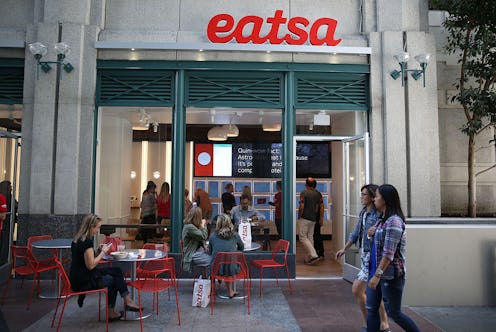Life
This Restaurant Doesn't Have Any Workers
Have you ever been deterred from eating out simply by the prospect of having to interact with people at the counter (and also having to put on pants)? At Eatsa, the fully automated restaurant that opened in San Francisco this week, you can experience the joys of not having to cook for yourself without having to speak to a single soul. Unless that creepy guy in line behind you tries to strike up a conversation while you're trapped, of course. And you still have to put on pants to go out in public.
OK, so it's not exactly the introvert's paradise it appears to be, but it's pretty darn close. Located near the Embarcadero in San Francisco, Eatsa is a high-tech, vegetarian restaurant where you can order, pick up, and eat your food without interacting with employees. Ordering is done on iPads, with a mobile option in the works if you're really feelin' the hermit life, and the food is prepared by the five or six kitchen staff hiding in the back like the house elves of Harry Potter. A few minutes later, your food appears in the small glass cubicles lining the wall, and you can scurry back to your apartment after a successfully people-free trip outdoors.
Eatsa's menu is completely quinoa-based, which the founders claim is better for the environment than meat-based restaurants. Needless to say, a quinoa-based, fully-automated San Francisco restaurant has gotten its fair share of ridicule.
Unlike most other places that produce food in the time it takes for you to walk over to the pick-up station, though, the food is apparently quite good — the food critic for the San Francisco Chronicle wrote that her burrito bowl was "perfectly cooked... [and] very filling." Similarly, a reporter for Business Insider wrote that she "loved the experience and the food was delicious." Plus, it's only $6.95 a bowl. What's not to love?
Who am I kidding? There's always something. In this case, some are claiming that Eatsa's automated service is indicative of a larger trend toward getting rid of employees entirely in the fast food industry. According to Business Insider, fast food workers' wages make up around 30 percent of the total industry costs, and analysts have pointed out that the push for automation could be spurred on by the demand to increase the minimum wage. However, NPR reports that spokespeople for many companies claim that they plan on moving employees from the front of the house to the kitchen, where the extra help will speed up food production.
That being said, Eatsa sounds pretty delicious, and it hardly needs any help in the speed department. Reporters and Twitter users are claiming that they receive their food in less than 10 minutes, and everyone agrees that the high-tech nature of the ordering process is just plain fun.
If this all sounds very Jetsons-like to you, that's because it is. Many have noted that Eatsa is reminiscent of automats, a style of restaurant that became immensely popular in the early-to-mid 20th century. Those of us who were born in the post-McDonald's era, however, are probably wondering the same thing. What exactly is an automat?
In a nutshell, they're old-school versions of Eatsa: Cafeteria-style restaurants in which customers ordered food from vending machines.Taking a cue from a German eatery called Quisiana Automat, the first American automat was opened in 1902 by business partners Joe Horn and Frank Hardart, under the uninspired name Horn and Hardart Automat. According to the Smithsonian website, the Philadelphia location quickly expanded to Times Square, where it truly took off.
Diners could buy macaroni and cheese, baked beans, chicken pot pie, and more for just a nickel, which you could pick up from the automat's cashiers, or "nickel throwers." According to Mental Floss, the automat's secret weapon was its drip-brewed coffee, which was uncharacteristically smooth and aromatic for the time period. In their heyday, automats serviced 350,000 customers a day and sold more than 90 million cups of coffee a year.
Later in the 20th century, business took a hit due to changing cultural tastes and suburban sprawl, but it was fast food restaurants that spelled the end of the automat. During the '70s, Horn and Hardart slowly replaced their restaurants with Burger Kings, and the last automat closed down in 1991.
That leaves us with one question: Will Eatsa become the modern automat? We'll have to wait and see.
